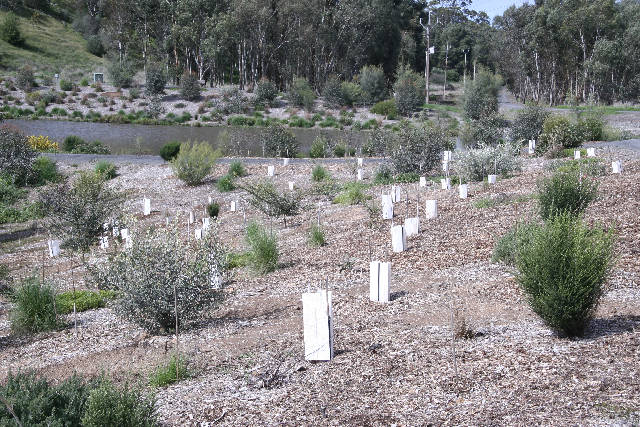This section was added in early December 2015
| |
| Some of the earlier guards
|
|---|

| The guards protected plants against browsing and also
from spray drift.
Photo date: 2015/08/20
| |
Autumn 2015
About 600
creeping boobialla cuttings were put into
square tubes during Autumn and right into winter.
Those that were planted in winter were kept in a cold frame (a small
greenhouse) to raise the temperature.
Rooting percentage was very high up until late winter when the rooting
process seemed to become less successful.
Several hundred seedlings in round plastic sleeves were received from
Trees For Life growers and from Council.
These were progressively planted out over the next few months.
Winter 2015
In the winter of 2016 a number of trees fell over, the roots having
insufficient hold in the sodden ground.
Quite a few
ruby salbush plants died too; apparently
due to some disease.
Winter of 2016 was much harder on the vegetation than the previous summer.
Many creeping boobialla rooted cuttings and Trees For Life seedlings were
planted during the winter of 2015.
Growth was very slow to the point of being negligible.
With very little growth the small plants were prey to browsing animals,
competition from weeds and possibly diseases, etc.
We started using guards in late July 2015; this seemed to have been very
effective in stopping browsing.
Spring 2015
Spring seems to me to be the best time of the year to plant in the Clare
Valley if the plants are expected to largely look after themselves.
| |
Can be done with a high success rate in Autumn in the open, and in the first
two months of Winter so long as a greenhouse is used.
I cut pieces about 150-200mm long, cut the leaves from the bottom half and
poked this into a 50mm x 50mm x 125mm square tube full of potting mix.
These were then kept damp for at least a month, by which time the great
majority of the cuttings had rooted.
Successful rooting could be checked by looking for roots coming out of the
bottom of the tubes.
|
|
I tried to plant about 20-25 plants every morning I had at the wetland in the
spring of 2015.
Method;
- Loosen an area of soil to near the depth of a digging fork about 30cm x
30cm;
- Plant seedling/rootling; (seedlings should not be pulled out of tubes;
plastic film tubes should be cut off, and reusable tubes containing
seedlings should be tapped on the top until the soil lump slides out).
- Saturate the loosened volume of earth (perhaps 5 litres of water);
- Place guard;
- Mulch inside and especially outside of the guard to a radius of about 40cm.
In my experience seedlings planted like this generally survive the Summer,
but if they can be soaked again once or twice during the summer, so much the
better.
On a few days in 2015 I planted
pigface cuttings, without any preliminary
rooting; this gave perhaps a 70% success rate.
More pigface cuttings were planted in late August of 2016.
Toward the end of spring 2015 about five more boxes of Trees For Life seedlings
were received from Council.
Summer 2015/16
Growth through the summer of 2015/16 was very strong.
Very few plants were lost to the heat or dryness.
The ground became too dry and hard for planting in early December of 2015
except
where the ground had been protected from evaporation by a thick layer of
mulch and there were few weeds and other plants.
2016 and early 2017
Planting continued when practical, but I did not keep specific notes, except
that around a hundred
yacca (
Xanthorrhoea quadrangulata)
seedlings were planted in late 2016.
I also planted an unknown number of mixed native species, perhaps 50 native
cypress-pine, (
Callitris preissii),
several native hibiscus, (
Alyogyne species), as well as a few
gungurru (silver princess,
Eucalyptus caesea)
and red capped gum (
Eucalyptus erythrocorys) in 2016.
Other Lions, particularly Allan Mayfield, have also planted at various times.
Late Winter 2017
Planting started on 2017/08/24 with a group of kids from Vineyard School.
They planed about a dozen seedlings and perhaps 50 boobialla and pigface
cuttings.
I consolidated many of these plantings and continued planting cuttings over
the following few days.
I have about a hundred seedlings that came from Ian Roberts for planting in
early Spring when the weather warms up a bit.